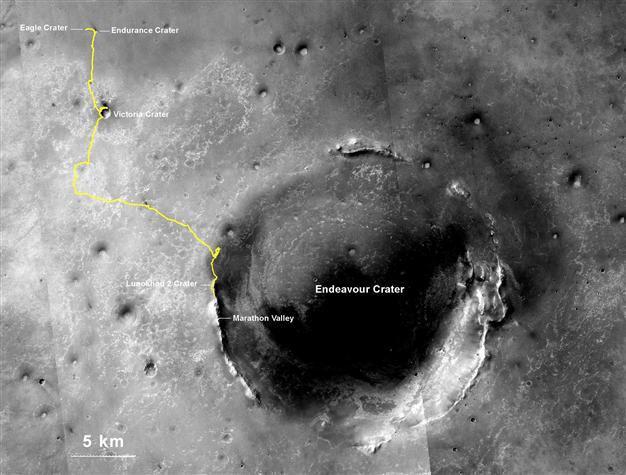NASA rover breaks out-of-this-world distance record
WASHINGTON - Agence France-Presse

The gold line on this map shows Opportunity's route from the landing site inside Eagle Crater (upper left) to its location after the July 27 (Sol 3735) drive. AFP Photo
The US space agency's Opportunity rover has now clocked more miles on Mars than any man-made vehicle to reach another celestial body, NASA said Monday.
Since arriving on the Red Planet in 2004, the solar-powered robot has journeyed across 40 kilometers of Martian terrain.
That surpasses the previous record held by the Soviet Union's Lunokhod 2 rover, which landed on the moon in 1973.
"Opportunity has driven farther than any other wheeled vehicle on another world," said Mars Exploration Rover Project Manager John Callas of NASA's Jet Propulsion Laboratory in Pasadena, California.
"This is so remarkable considering Opportunity was intended to drive about one kilometer and was never designed for distance."
Opportunity and its twin rover, Spirit -- now defunct -- discovered wet environmental conditions on ancient Mars, some of which are mild enough to have been favorable for life.
Opportunity is now exploring the Endeavour Crater on Mars.
Its next-generation robotic counterpart, the Curiosity rover, launched in 2012 and is tooling around near the Gale Crater on Mars.
But despite its bigger size and more advanced suite of scientific tools, NASA spokesman Guy Webster said the $2.5 billion dollar Curiosity vehicle is not likely to break Opportunity's record.
"Curiosity has driven about 5.3 miles (8.6 kilometers) so far," Webster told AFP in an email.
"The main science destinations for Curiosity, on lower Mount Sharp, are much closer than the 20 miles it would take to surpass Opportunity's current total," he added.
"Also, as Curiosity's mileage increases, who knows how much longer and farther Opportunity will keep driving?"
NASA said that the Soviet Union's Lunokhod 2 rover landed on Earth's moon on January 15, 1973, and drove about 24.2 miles (39 kilometers) in less than five months.
Those figures are based on calculations recently made using images from NASA's Lunar Reconnaissance Orbiter (LRO) cameras that reveal Lunokhod 2's tracks, the US space agency said.
